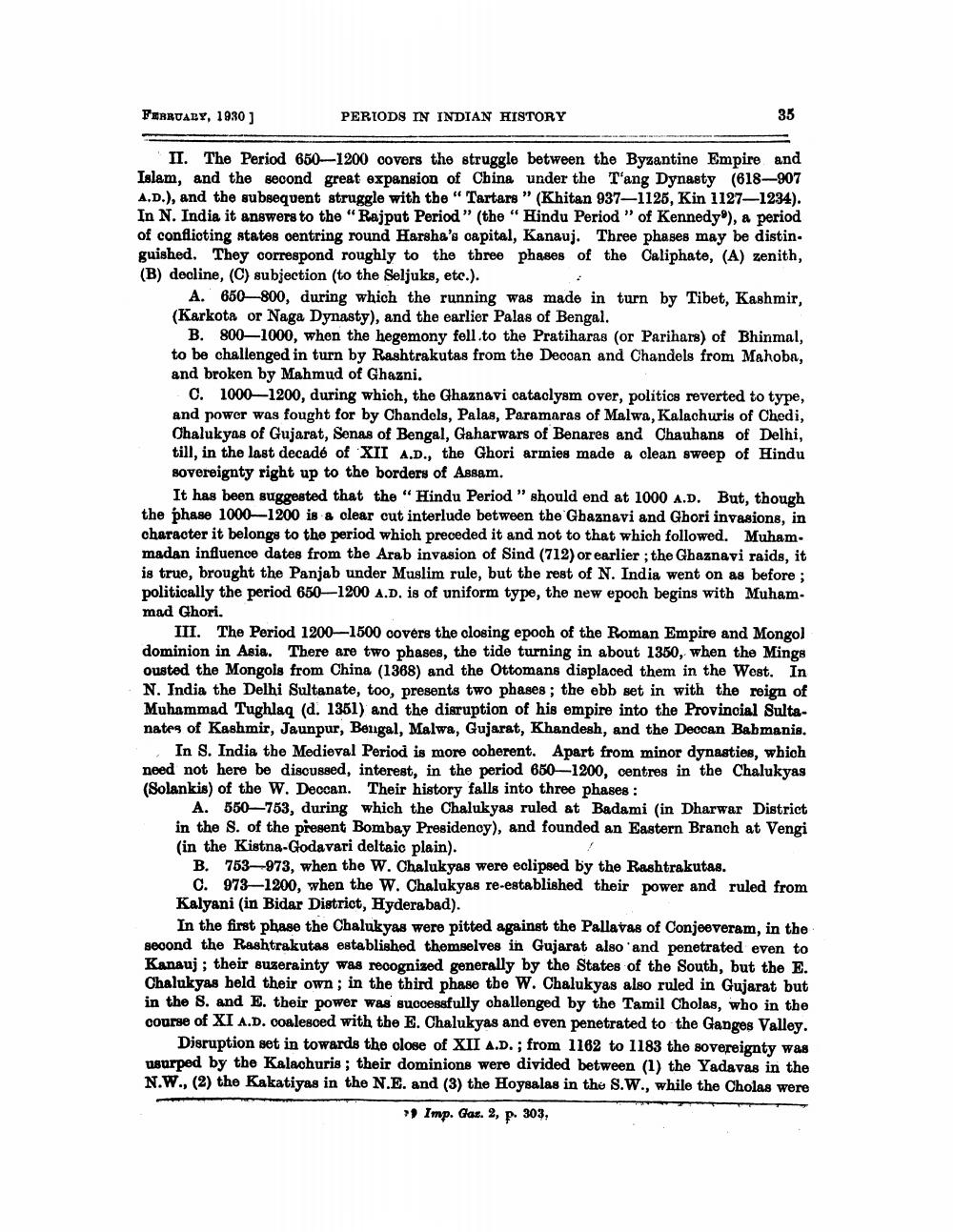________________
FEBRUARY, 1930]
PERIODS IN INDIAN HISTORY
35
II. The Period 650-1200 covers the struggle between the Byzantine Empire and Islam, and the second great expansion of China under the Tang Dynasty (618-907 A.D.), and the subsequent struggle with the "Tartars" (Khitan 937-1125, Kin 1127-1234). In N. India it answers to the "Rajput Period" (the "Hindu Period" of Kennedy), a period of conflicting states centring round Harsha's capital, Kanauj. Three phases may be distin. guished. They correspond roughly to the three phases of the Caliphate, (A) zenith, (B) decline, (C) subjection (to the Seljuks, etc.).
A. 650-800, during which the running was made in turn by Tibet, Kashmir, (Karkota or Naga Dynasty), and the earlier Palas of Bengal.
B. 800-1000, when the hegemony fell to the Pratiharas (or Parihars) of Bhinmal, to be challenged in turn by Rashtrakutas from the Deccan and Chandels from Mahoba, and broken by Mahmud of Ghazni.
C. 1000-1200, during which, the Ghaznavi cataclysm over, politics reverted to type, and power was fought for by Chandels, Palas, Paramaras of Malwa, Kalachuris of Chedi, Chalukyas of Gujarat, Senas of Bengal, Gaharwars of Benares and Chauhans of Delhi, till, in the last decade of XII A.D., the Ghori armies made a clean sweep of Hindu sovereignty right up to the borders of Assam.
It has been suggested that the "Hindu Period" should end at 1000 A.D. But, though the phase 1000-1200 is a clear cut interlude between the Ghaznavi and Ghori invasions, in character it belongs to the period which preceded it and not to that which followed. Muhammadan influence dates from the Arab invasion of Sind (712) or earlier; the Ghaznavi raids, it is true, brought the Panjab under Muslim rule, but the rest of N. India went on as before; politically the period 650-1200 A.D. is of uniform type, the new epoch begins with Muham. mad Ghori.
III. The Period 1200-1500 covers the closing epoch of the Roman Empire and Mongol dominion in Asia. There are two phases, the tide turning in about 1350, when the Mings ousted the Mongols from China (1368) and the Ottomans displaced them in the West. In N. India the Delhi Sultanate, too, presents two phases; the ebb set in with the reign of Muhammad Tughlaq (d. 1351) and the disruption of his empire into the Provincial Sultanates of Kashmir, Jaunpur, Bengal, Malwa, Gujarat, Khandesh, and the Deccan Bahmanis.
In S. India the Medieval Period is more coherent. Apart from minor dynasties, which need not here be discussed, interest, in the period 650-1200, centres in the Chalukyas (Solankis) of the W. Deccan. Their history falls into three phases:
A. 550-753, during which the Chalukyas ruled at Badami (in Dharwar District in the S. of the present Bombay Presidency), and founded an Eastern Branch at Vengi (in the Kistna-Godavari deltaic plain).
B. 753-973, when the W. Chalukyas were eclipsed by the Rashtrakutas.
C. 973-1200, when the W. Chalukyas re-established their power and ruled from Kalyani (in Bidar District, Hyderabad).
In the first phase the Chalukyas were pitted against the Pallavas of Conjeeveram, in the second the Rashtrakutas established themselves in Gujarat also and penetrated even to Kanauj; their suzerainty was recognized generally by the States of the South, but the E. Chalukyas held their own; in the third phase the W. Chalukyas also ruled in Gujarat but in the S. and E. their power was successfully challenged by the Tamil Cholas, who in the course of XI A.D. coalesced with the E. Chalukyas and even penetrated to the Ganges Valley.
Disruption set in towards the close of XII A.D.; from 1162 to 1183 the sovereignty was usurped by the Kalachuris; their dominions were divided between (1) the Yadavas in the N.W., (2) the Kakatiyas in the N.E. and (3) the Hoysalas in the S.W., while the Cholas were
Imp. Gaz. 2, p. 303,




